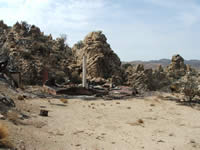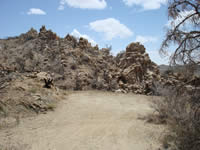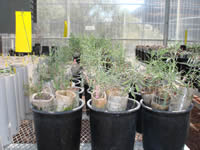
National Fire Plan Success Story
Rehabilitating Burned-Over Building Sites
Joshua Tree National Park, California
National Fire Plan - Rehabilitation
2008

The remains of a burned over structure in the Whispering Pines Subdivision, Joshua Tree National Park. Debris posed a hazard to park staff, visitors and wildlife.

Bare soil left in place after debris removal and susceptible to erosion was stabilized using vertical mulch and planting live native shrubs and grasses from the burned area.

Native shrubs from unburned islands in the Whispering Pines Subdivision are propagated at Joshua Tree National Park’s Center for Arid Lands Restoration.
Photos by Joshua Tree National Park staff.
In July 2006, Joshua Tree National Park was primed for fire with a very dry and very high fine fuel load. These highly combustible fuels ignited during two separate lightning events in the Covington Flats and Whispering Pines areas of the park, and the resulting fire quickly spread across the arid landscape, burning a total of 1,525 acres.
The fire burned through many park and privately owned structures in the Whispering Pines Subdivision, leaving behind debris that posed a potential hazard to park staff, visitors, wildlife, and cultural resources. The highest priority to restore the ecology of the Whispering Pines area identified in the Burned Area Emergency Response (BAER) plan was to mitigate safety risks and potential resource damage posed by this debris. Removal of debris left large denuded areas of unstable soil that were susceptible to erosion. Revegetation and vertical mulching of these denuded areas were specified in the BAER plan to stabilize soils, and hasten the restoration of Mojave Desert vegetation.
The park received substantial precipitation during the winter of 2007-2008, which benefited natural recovery of the Whispering Pines area. Native annuals carpeted the burned area in the spring, and many native shrubs and perennial grass species resprouted. Joshua Tree National Park’s Center for Arid Lands Restoration (CALR) has propagated sixteen different native plant species collected from unburned vegetation islands within the Whispering Pines subdivision. These native shrubs and grasses represent a good proportion of perennial diversity of the burned over vegetation, and include both early colonizers of disturbed areas such as Apricot Mallow (Sphaeralcea ambigua), and slower growing native shrubs such as Mormon Tea (Ephedra nevadensis). Park staff will outplant into denuded areas in fall 2008, when plants will receive maximum benefits of winter rains, and have an excellent chance of survival. Moisture needs of the transplants will be supplemented with Driwater®, a gel that provides slow release irrigation directly to plant roots. Each plant will be protected from herbivores by a natural mammal repellent. Park staff will monitor the project. Natural recovery, along with supplemental revegetation of the denuded former building sights, is gently helping to restore this burned area of the desert.
Contact: Alice Miller, Vegetation Branch Chief, (760) 367-5564.